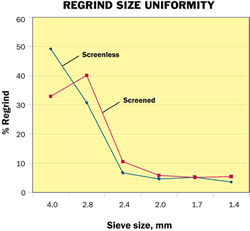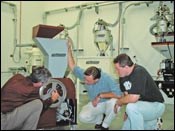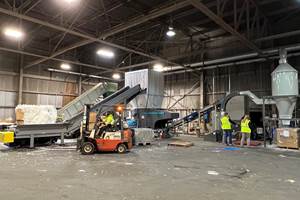Eliminate Dust, Fines and Longs For Better Regrind Quality
Considering the high cost of resin and heightened concerns for product quality, it is surprising that so little attention is given to the impact of regrind quality on plastics processing.
Considering the high cost of resin and heightened concerns for product quality, it is surprising that so little attention is given to the impact of regrind quality on plastics processing. Material is one of the biggest costs of doing business, so it’s imperative to minimize waste and make effective use of reclaimed resin. Using regrind can be trouble-free if a few simple steps are followed.
The most common processing problems associated with regrind—apart from contamination—are the result of dust, fines, and “longs.” The type of granulator—screened or screenless—has a different effect on the quality of regrind because of the different cutter designs and throughput options. In either case, proper operation and maintenance of the granulator for the specific application will ensure the best quality regrind.
Check out the granulator
If your granulator is more than a few years old or you have no defined preventive-maintenance program, then it’s probably time to take a closer look at your equipment. Dust and fines are caused by dull knives, improperly gapped knives, plugged screens, excessive rotor speed, and screen holes that are too small (often in an attempt to reduce “longs”).
Dust and fines can result in conveying problems such as bridging or rat-holing, which prevent all the material from being evacuated from the granulator discharge bin. Other problems include build-up in the feed hopper, which can block the discharge; and clogged filters, which reduce the ability to convey material. Dust in the air can make for unpleasant odors in the plant and add to housekeeping burdens.
Once the regrind gets back into your process, additional problems such as black specks can occur because dust and fines melt faster than virgin pellets and may degrade faster. Dust and fines thus increase rejects and add cost for inspection to identify bad parts.
Every processor using regrind has experienced one or more of these problems at some time. The solution is simple: Eliminate or at least minimize dust, fines, and longs. A screenless granulator eliminates longs, so further discussion of longs will apply only to screened granulators.
Monitor your regrind
A few simple tests can quickly monitor the quality of regrind. The first consists of nothing more than putting your hand into a container of regrind (not into the granulator!) and examining a handful of material. Look at the consistency of the regrind. Are the pieces all roughly about the same size or are some pieces much larger? How do most of the particles compare with the size of the pellets you are using?
Now, drop the material back into the container. How much dust and fines remain on your hand? There shouldn’t be much, if any, for a properly specified granulator that is operating properly.
For a more quantitative approach, ask your quality-assurance department or the granulator manufacturer to perform a simple sieve test on a representative sample (5 to 10 lb) of regrind. Using a set of scientific sieves, the supplier can provide an accurate measure of the percentage of material that is dust and fines as compared with good quality regrind. The same goes for longs if you are using a screened granulator.
An even better exercise is to also send the granulator supplier some sample parts, runners, tabs, and tails, along with complete application information (including type of material and feeding rates) to determine the type of granulator that is best for your application.
Screened vs. screenless
There may not be a lot you can do about the design of your granulator, but a few simple adjustments can quickly reduce the amount of dust, fines, and longs in your regrind. Because of the fundamental differences between screened and screenless granulators, we need to identify the specific problems associated with each to determine the preventive maintenance that is required. For comparison purposes, we will consider a cutting-chamber size of approximately 8 × 16 in.
Screened granulators of this size come with a sizing screen, rotor speed of 200 to 600 rpm, motor of 3 to 15 hp, and throughput of 125 to 150 lb/hr. Screenless versions have no sizing screen, rotor speed of around 30 rpm, 1 to 3 hp, and throughput of 25 lb/hr.
Longs occur when pieces of scrap slip through a screen before they have been sufficiently reduced in size. This can be eliminated with a screenless granulator if the application fits. If not, or if a screened granulator is preferred, one solution is to reduce the size of the screen holes. However, this may increase your percentage of fines and/or reduce your throughput. Sometimes slowing the rotor speed along with reducing screen-hole diameter will minimize or eliminate longs without increasing fines. Another solution is to drill the screen holes at an angle to make it harder for long pieces to fit through.
It is essential for the screen holes to remain open in order to maintain regrind quality, energy efficiency, and high throughput. Plugging occurs when the open screen area is reduced and material that is already cut to a proper size cannot get through. It gets swept around by the rotor and cut over and over, creating fines. Having to unplug the screen requires unscheduled downtime and added maintenance cost. Again, this problem can be eliminated with a screenless granulator if the application fits. If not, or a screened granulator is preferred, use a screen with conical holes (countersunk from the bottom). This will make it easier for ground material to pass through the screen and reduce the chance of plugging the holes. At the very least, this type of hole will be easier to clear during routine maintenance.
Ten to 15 years ago, most granulators operated at about 600 rpm, which resulted in more dust and fines. Since then, rotor speeds have been reduced with excellent results. Many beside-the-press granulators today operate at 200 to 300 rpm. Screenless granulator rotors turn at around 30 rpm and provide the best quality of regrind for hard, brittle materials that tend to fracture upon impact.
Two ways to reduce rotor speed on existing granulators are to change to a lower rpm/higher torque motor or to change drive pulleys. Many older, high-speed granulators have less expensive 1800-rpm (four-pole) motors. A 1200-rpm (six-pole) motor will reduce rotor speed by one-third while maintaining knife-tip force, even with lower horsepower. A six-pole motor has 50% more torque than a four-pole motor. Changing a rotor pulley can be a less costly solution if there is sufficient room within the guarding for a larger pulley. Contact your granulator manufacturer to determine the best solution for your specific model.
When knives don’t cut it
Two major reasons for dust and fines are dull or improperly gapped knives. The sharper the knives, the more efficiently the granulator will chop the scrap, especially with soft, energy-absorbing materials. Sharper knives will produce a cleaner cut without tearing, resulting in greater energy efficiency, higher throughput, and fewer fines.
Older granulators were not designed to facilitate easy knife changes. With the high cost of materials and smaller maintenance budgets, it’s important that granulators be designed for easy knife changes. Knife-gap pre-adjustment fixtures and fast access to the cutting chamber are important features that make it easier to routinely change knives and improve regrind quality.
Properly gapped knives on a screened granulator—and cutters on a screenless granulator—are critical to minimize fines and dust while maximizing energy efficiency and throughput. This is especially important when cutting energy-absorbing materials. Both rotating and stationary knives should have adjustable gaps. This is true for both screened and screenless granulators.
Gapping each knife independently allows the smallest gap possible for each knife. This is not possible with fixed (non-adjustable) rotor knives. Another important benefit of adjustable knives is the ability to sharpen each knife independently rather than together as a set. This allows for the smallest amount to be ground off each knife, resulting in longer knife life.
It is still surprising to see how many processors wait for costly problems to occur in scrap reclaiming before taking action. It takes a relatively small amount of time to maintain a granulator—either screened or screenless—so it can operate at maximum efficiency and produce good-quality regrind. Investing a couple minutes to examine regrind quality the next time you walk by a granulator or bin of material will undoubtedly pay for itself in the long run.
Robert Harrison is granulator product manager at Wittmann Inc. in Torrington, Conn. During his 16 years in plastics, he has worked in application and product development and marketing for Nelmor, Conair, and Sterling/Ball & Jewel. Harrison can be reached at (860) 496-9603, or e-mail bharrison@wittmann-ct.com.
Related Content
Scaling Up Sustainable Solutions for Fiber Reinforced Composite Materials
Oak Ridge National Laboratory's Sustainable Manufacturing Technologies Group helps industrial partners tackle the sustainability challenges presented by fiber-reinforced composite materials.
Read MoreMultilayer Solutions to Challenges in Blow Molding with PCR
For extrusion blow molders, challenges of price and availability of postconsumer recycled resins can be addressed with a variety of multilayer technologies, which also offer solutions to issues with color, processability, mechanical properties and chemical migration in PCR materials.
Read MoreHow to Optimize Color Evaluation of Recycled Plastics
The right color measurement instrument and good working methods will minimize variability in color evaluation of PCR.
Read MorePurpose-Built System Enhances Capacity and Flexibility for Recycler
A Boston recycler invested in a turnkey shredding, granulation and elutriation system to expand its plastics reclaim business.
Read MoreRead Next
Beyond Prototypes: 8 Ways the Plastics Industry Is Using 3D Printing
Plastics processors are finding applications for 3D printing around the plant and across the supply chain. Here are 8 examples to look for at NPE2024.
Read MorePeople 4.0 – How to Get Buy-In from Your Staff for Industry 4.0 Systems
Implementing a production monitoring system as the foundation of a ‘smart factory’ is about integrating people with new technology as much as it is about integrating machines and computers. Here are tips from a company that has gone through the process.
Read More















